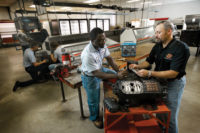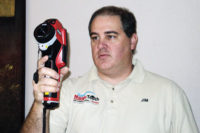
The Bosch Therm C 1210 ES gas tankless water heater is a fully condensing unit that captures latent condensation heat from the exhaust gas and uses it to preheat the incoming cold water.
As new technologies are being developed and applied to the once less-than-glamorous water heater, consumers are becoming more aware of this product. Instead of being an afterthought, the water heater is gaining consumer recognition due to the efficiencies that can be achieved by the newer units.
According to water heater manufacturers, two of the main trends driving interest in water heaters are consumers’ desires to save money and preserve the environment. Government regulations and incentives have also spurred interest in efficient water heaters. And contractors who are ready to educate themselves on how to best sell and service these products may find new opportunities to heat up their profits.
NEW TECHNOLOGIES AND TRENDS
According to Eric Klingler, branch manager for the Northeast region at Noritz America, consumers have three basic options when their old water heater gives out: “They can stay with the old standard, the tank water heater (which usually is not Energy Star-qualified); upgrade to a tankless water heater on the gas side; or upgrade to a heat pump water heater on the electric side.”The tankless technology, which heats water as it is needed instead of heating it continually in a storage tank, is becoming more popular as consumers look for ways to save on utility bills. Joe Holliday, director of marketing and product development for Rinnai, said, “We believe that tankless technology appeals to consumers because the lifestyle benefits it offers are immediate and noticeable - continuous hot water means no chance of a cold shower.” He continued, “Being able to run multiple hot water appliances at the same time is a major convenience for busy families and the elimination of the traditional tank water heater translates to extra storage space. Plus, you’ve got the added benefit of energy savings, which means a lower utility bill each month.”
David Chisolm, brand manager for A.O. Smith, agreed that savings are a major motivation for homeowners to upgrade their water heaters. “As consumers are becoming more aware of their energy consumption and are making efforts to reduce their monthly expenses, these technologies are becoming more mainstream,” Chisolm said, noting that consumer demand for more energy-efficient water heaters spans both the commercial and residential markets.

The Rheem ultra high efficiency Prestige™ condensing tankless water heater vents with PVC piping rather than stainless steel, making installation easier and saving contractors on installation costs and time.
Chisolm added, “Regardless of the application and fuel source, there are many high efficiency options now available.” He noted that his company’s portfolio of high-efficiency water heaters includes solar, hybrid gas, hybrid electric, and tankless models, and added that all of these products have increased in popularity as consumers have begun paying more attention to energy-efficient appliances.
Government incentives for water heaters have also heightened consumer awareness and interest in these products. According to Joe Holliday, director of marketing and product development for Rinnai, “The idea of energy savings is the force behind new water heating technology today. Consumers are seeing their energy bills go up and are interested in replacing all of their appliances with energy-efficient models. This interest has grown thanks to the federal government and individual state tax incentives offered for energy-efficient home improvements. ”
Mark Sullivan, national sales manager of Bosch’s thermotechnology group, said, “When you couple these products with a greater overall trend of energy savings, fueled by government incentive programs like tax credits for qualifying products, water heating costs have been reduced by 50 percent in some cases.”

The Noritz NR83-DVC heats water strictly on demand. With inputs ranging from 18,000 to 180,000 Btuh and flow rates from 0.5 to 8.3 gpm, it is designed specifically for one-bathroom homes in the Northeast, Midwest, and Canada, as well as two-bath homes in the Southeast and Southwest.
Peter Reynolds, vice president and general manager for Rheem Water Heating, agreed that the trends toward green and government regulation are advancing new water heaters, but he also noted that new trends in residential construction are playing a role.
“The increasing number of consumers downsizing homes and builders producing smaller houses are also playing a key role in the need for diversified and innovative water heating solutions,” he said. According to Reynolds, Rheem’s newly introduced integrated heating and water heating system is an example of how Rheem is addressing these needs. “The system uses tankless water heating for both domestic hot water and home heating, saving space in the home, providing energy efficiency, and making installation simpler for contractors,” he said.
Reynolds also added that the growing consumer preference for “simplicity and convenience” is increasingly being satisfied with new technology and controls features.

Fayette Mechanical Services (Peachtree City, Ga.) installs Rinnai tankless water heaters to provide customers with continuous hot water and energy savings. Rinnai’s condensing tankless water heaters operate at up to 95 percent thermal efficiency.
SEIZE THE OPPORTUNITY
While consumers are growing increasingly interested in upgrading their water heaters, many contractors may not have caught up to the trends. According to Reynolds, “Many consumers have reported to us recently that they are particularly asking for more efficient, technologically advanced products like tankless and hybrid options, only to have a contractor point them back to a more traditional water heater.” He continued, “Contractors have a real opportunity to use their technical skills to offer a more technologically advanced product that’s in demand by homeowners who are willing to pay for the benefits they provide.”It’s certainly the time for contractors to seize the opportunity to offer these complementary product lines to their customers. “Contractors should capitalize on the trend that consumers are becoming more aware and interested in their water heating options,” Chisolm said. “These new models provide the opportunity for contractors to offer customized solutions that will ultimately make their customers happier with their selection. A more satisfied customer will lead to additional business and provide more upsell opportunities for the contractor.”
The first step to seizing the opportunity is an open mind. “First, HVAC contractors need to be open to adding these products to their portfolio,” Reynolds said. “Because HVAC contractors already have many of the necessary technical skill sets, entry into offering water heating solutions is typically an easier one.”
Holliday agreed that there is a lot of opportunity for HVAC contractors “to grow their business by adding tankless water heater installation to their service offerings.” He noted, “Rinnai tankless models are powered by natural gas or propane just like most furnaces, so their installation requires a similar skill set to that possessed by HVAC installers.”
But although it may be fairly simple for contractors to expand into water heaters, they should not assume they can jump in without any education or training. “Education on the product and installation methods is essential for the HVAC professional,” Sullivan said.
Contractors should build on the skills they already have while seeking training on the new products they want to offer customers. Water heater manufacturers generally offer training to bring contractors up to speed on their products. For example, Rheem offers basic hands-on training as well as sales training. Bosch has three solutions centers nationwide that offer hands-on training for the company’s geothermal, solar, boiler and tankless applications, and plans to offer online courses in the future. Rinnai provides comprehensive installation training classes for installers across the country, and Noritz America offers a multi-level training curriculum, along with technical support for contractors.
As contractors learn more about the latest offerings in water heaters, they can prepare to not only sell but also service these products. “While many contractors can put a tankless water heater in, not everyone can service what they install,” Klingler said. “To be a high-end installer who can justify top dollar on the installation, you really need to set the homeowner at ease that you are there for the long haul.”

The A. O. Smith Voltex hybrid electric heat pump water heater pulls heat from the surrounding air and deposits it into the 80-gallon storage tank, allowing the heater to operate in the most efficient mode.
CUSTOMER EDUCATION
Yet as contractors begin to offer water heating products, they also must be ready to respond to the most common concerns and complaints of customers. According to the manufacturers, contractors should be careful to educate and inform customers about the water heating technology they are purchasing, so they do not have unrealistic and unmet expectations after installation.“Some consumers misunderstand the concept of tankless and think that when they install a tankless water heater they will have instant hot water at the tap,” Holliday said. “While tankless units heat water instantly at the unit, the water needs to travel from the unit to the tap, so there will still be a few seconds of cold water as the water in the pipe run is flushed out. Contractors need to educate their customers about this and make sure homeowners equate tankless technology with continuous hot water, not instant hot water.”
Sullivan added, “The recommendation for installers is to use on-demand pumps and recirculation type systems for customers that require quicker hot water delivery.”
Klingler added that, on the installation side, “Homeowners want to know what the vent termination will look like from the outside of the house. They also want to know if it is costly to upgrade a gas line if that proves to be necessary.”
Overall, contractors need to be prepared to meet the demands of their customers. As more and more people hear about the benefits of tankless water heaters and renewable power options, they will turn to the contractor they know and trust to provide them with these products.
Klinger said, “Overall, my advice is to get into this business now and develop a strong expertise around a leading product line. Develop a reputation locally as the go-to contractor with in-depth knowledge and unsurpassed professionalism. Water heating is becoming a lot more complex than it was just a few years ago. There is a new level of opportunity for the taking by the right companies.”
Publication date:11/08/2010






